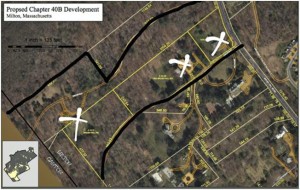The price of development ~ Part 3
By Guest(Click here to go back to part 2 or part 1)
The nearest fire station in Canton is on Surrey Lane right off of Washington Street near Crowell’s market. The Canton fire truck or ambulance would still have to get down Route 138, which would be no easy feat, especially with the additional traffic from the development.
Below is the traffic that a Canton emergency vehicle would have to get through in order to respond to the neighborhood.
Brush Hill Road is also lined with historic stonewalls and is very narrow. There is no place for sidewalks, and without them it would be unsafe to walk the mile or so from the proposed development to Hyde Park where commuters get trains, and there is no currently available public transportation as an alternative.
Reaction to the proposed development
Objecting to a 300-unit apartment building could be portrayed as a predictable “not in my back yard” reaction.
But the local residents aren’t in opposition to creating affordable housing, quite the contrary. For this modest and historic community it is a matter of scale. Putting in a few affordable, single-family houses on buildable land would be welcomed by the immediate community. But stacking up three and four story buildings and parking areas in this small and special area, thrusting hundreds of cars onto roadways already jammed to capacity, is overburdening this immediate neighborhood and the broader community.
If it was an industrial area or an old mill that was being transformed that would be one thing; but to throw up such a dense development on top of a historically preserved area that abuts conservation and wetlands is very different.
Affordable housing doesn’t have to mean brand-new, large-scale, multi-hundred-unit developments. There are ways towns can work toward a quota. The town can evaluate the current housing stock and make adjustments. Milton’s developers could be required to work with the town to contribute toward the goal of providing some affordable housing in their plans, and if they can’t create actual housing they could contribute to the Milton Affordable Housing Production Fund. The planning board is talking about doing an assessment of future plans with this in mind. If the town could think of ways to create affordable houses and rentals on a smaller scale, it would seem that they would be more easily absorbed into the community.

The black outlines the properties involved and white marks the three houses that would be torn down to build the proposed development. (Courtesy of Deborah Felton of Fuller Village)
Increasingly, people are also understanding that affordable housing should serve the people in need of affordable housing, not the profit of huge developers with distant corporate headquarters. Mill Creek Residential Trust’s vice president of development, Robert Hewitt, said it plans to make a filing soon. Hewitt was recently quoted as saying, “We feel that Milton is an exceptional town and that we can add benefit to the town by creating this housing product.”
But their website (mcrtrust.com) includes the following quotes, which are far less altruistic toward the local community: “Mill Creek Residential is passionately dedicated to delivering superior returns … Our team boasts a proven strategy and platform that has historically delivered strong returns to investors.”
Mill Creek is a corporation with its headquarters in Texas. It specializes in building huge numbers of apartment buildings. The company’s website crows that in the past year, Mill Creek Residential started construction on over 3,100 apartment units, expects to start construction on approximately 6,000, and has a goal to identify approximately 5,000 units annually. Mill Creek, the website extols, has “executed over $12 billion in transactions since 1993 … across major U.S. markets.”
All of this makes clear the obvious: Mill Creek is a housing development machine whose primary mission is to sustain quarter over quarter growth for stockholders, and this makes it indifferent to whether its projects align with the “exceptional” qualities of communities like Milton and Canton. It simply has no stake in, and no means of recognizing the value of decades of local history and conservation. The towns — its citizens and leaders — are the only ones suited to do that. While affordable housing is important for any town, it would be shortsighted for the local and state community if this proposed development were fast-tracked, bypassing assessment of the long-term value of conservation and historic and wildlife preservation.
As the previous owner of our home said, “This little place in the world is special, and people either get that or they don’t.” Unfortunately, one corporate bulldozer and hundreds of years of shared public and private sector investment, conservation and preservation is irrevocably gone.
Denny Swenson is an award-winning television producer and resident of Hemenway Drive. Half of her house is in Canton and half is in Milton.
Short URL: https://www.thecantoncitizen.com/?p=19290











